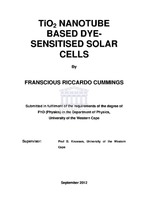| dc.description.abstract | The first report of a functioning photo-electrochemical solar cell in 1991 attracted a lot of interest from scientists and industrial groups. From an industrial point of view these so-called dye-sensitised solar cells (DSCs) offered the promise of moderate efficiency devices at ultra-low costs, owing to simple processing methods and the use of inexpensive materials. From an academic viewpoint, DSCs raised important scientific questions around the fundamental processes governing their operation and how these processes influence the photon-to-electron conversion efficiency of the cell. Major successes have since been achieved in understanding these processes, however the conversion efficiency of the best manufactured DSCs remains around 11%, significantly lower than that of their silicon photovoltaic counterparts. In traditional DSCs, charge generation is achieved by ultrafast electron injection from a photo-excited ruthenium-based dye molecule into the conduction band of a film of TiO₂ nanoparticles, subsequent dye regeneration by an I⁻ /I⁻₃ containing redox electrolyte and finally hole transportation to a platinum-coated counter electrode. The low DSC efficiencies are attributed to scattering of electrons at the interface between two TiO₂ nanoparticles leading to recombination with holes present in the redox electrolyte. Recent studies have shown that the application of films of highly ordered TiO₂ nanotubes instead of nanoparticles has the
potential to improve the overall conversion efficiency of the cell. This is ascribed to the one-dimensional nature of nanotubes, which provides a linear transportation route for electrons generated during operation of the DSC. As a result the recombination probability of the electrons with nearby holes in the device is decreased. This work investigated the synthesis of Al₂O₃-coated TiO₂ nanotubes via the anodisation technique for application in DSCs. TiO₂ nanotube arrays with an average length of 15 μm, diameter of 50 nm and wall thickness of 15 nm
were synthesised via anodisation using an organic neutral electrolyte consisting of 2 M H₂O + 0.15 M NH₄F + ethylene glycol (EG) at an applied voltage of 60 V for 6 hours. In addition, scanning electron microscope (SEM) micrographs showed that anodisation at these conditions yields nanotubes with smooth
walls and hexagonally shaped, closed bottoms. X-ray diffraction (XRD) patterns revealed that the as-anodised nanotubes were amorphous and as such were annealed at 450 °C for 2 hours in air at atmospheric pressure, which yielded crystalline anatase TiO₂ nanotubes. Highresolution transmission electron microscope (TEM) images revealed that the nanotube walls comprised of individual nano-sized TiO₂ crystallites. Photoluminescence (PL) spectroscopy showed that the optical properties, especially the bandgap of the TiO₂ nanotubes are dependent on the
crystallinity, which in turn was dependent on the structural characteristics, such as the wall thickness, diameter and length. The PL measurements were supplemented by Raman spectra, which revealed an increased in the quantum confinement of the optical phonon modes of the nanotubes synthesised at low
anodisation voltages, consequently yielding a larger bandgap
The annealed nanotubes were then coated with a thin layer of alumina (Al₂O₃) using a simple sol-gel dip coating method, effectively used to coat films of nanoparticles. Atomic force microscopy (AFM) showed that the average nanotube diameter increased post sol-gel deposition, which suggests that the
nanotubes are coated with a layer of Al₂O₃. This was confirmed with HR-TEM, in conjunction with selected area electron diffraction (SAED) and XRD analyses, which showed the coating of the nanotube walls with a thin layer of amorphous Al₂O₃ with a thickness between 4 and 7 nm. Ultraviolet-visible (UVvis)
absorbance spectra showed that the dye-adsorption ability of the nanotubes are enhanced by the Al₂O₃ coating and hence is a viable material for solar cell application. Upon application in the DSC, it was found by means of photo-current density – voltage (I – V) measurements that a DSC fabricated with a 15 μm thick layer of bare TiO₂ nanotubes has a photon-to-light conversion efficiency of 4.56%, which increased to 4.88% after coating the nanotubes with a layer of alumina. However, these devices had poorer conversion efficiencies than bare and Al₂O₃-coated TiO₂ nanoparticle based DSCs, which boasted with efficiencies of 6.54 and 7.26%, respectively. The low efficiencies of the TiO₂ nanotube based DSCs are ascribed to the low surface area of the layer of nanotubes, which yielded low photocurrent densities. Electrochemical impedance spectroscopy (EIS) showed that the electron lifetime in the alumina coated nanotubes are almost 20 times greater than in a bare layer of nanoparticles. In addition, it was also found that the charge transfer resistance at the interface of the TiO₂/dye/electrolyte is the lowest for an Al₂O₃-coated TiO₂ layer. | en_US |

